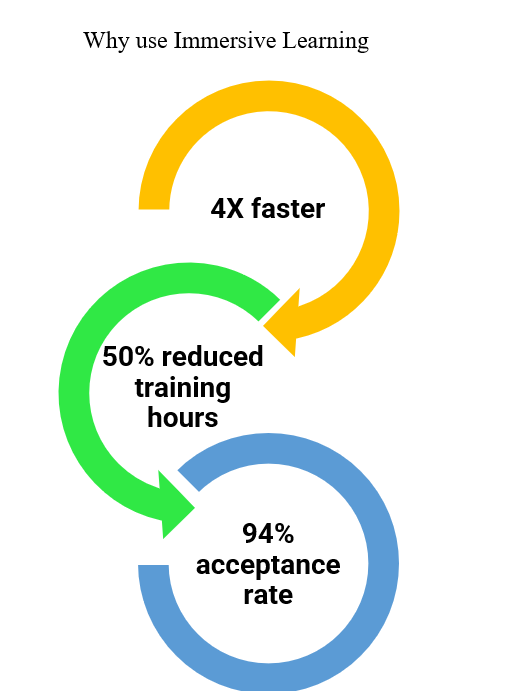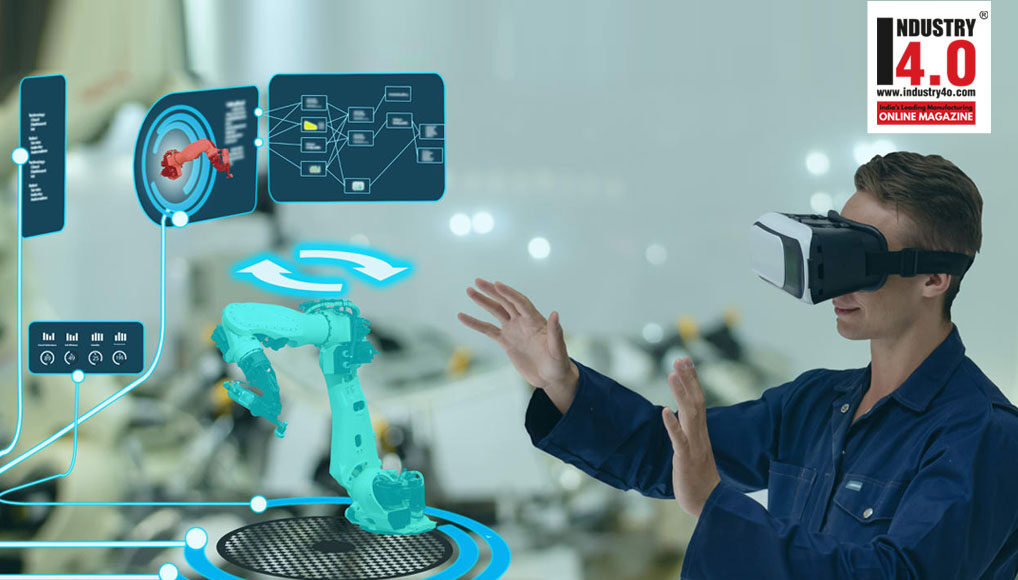The manufacturing industry is building back fast, undeterred by the pandemic. However, there are larger issues ranging from supply chain challenges, dealing with COP 26 regulations, sustainability goals, shortage of skilled workforce, unclear roles of the workforce with the rise of automation, and last but not the least attracting the millennials into the sectors (the tech-savvy generation), all this has the potential to become the spiral straw looping the manufacturing industry and dislocating the spine of manufacturing. This can be classified as the “SWIRL problem “ SWIRL is an acronym standing for
- S = The skills gap
- W = Workers’ roles with the rise of automation
- I = Interconnected workforce
- R = Retaining and attracting workers
- L = The labor shortage
 Fortunately, there is a way out and a way forward. The solution is to embrace and integrate the new-age learning and training technologies that create a sense of purpose for the workers on the company’s vision of equitable and quality training for everyone. Automation of mundane tasks, Immersive and Interactive training methodologies have taken almost every other industry by storm by delivering evidence-based results like optimized performance, consistency, higher engagement, faster training time, increased recall rate, and higher satisfaction overall to the workforce that is born in the digital age. I have been pondering over a nice acronym that I can use to structure my thoughts on how immersive training has the potential to disrupt the manufacturing industry and that is exactly what I have done in the next 2 sections.
Fortunately, there is a way out and a way forward. The solution is to embrace and integrate the new-age learning and training technologies that create a sense of purpose for the workers on the company’s vision of equitable and quality training for everyone. Automation of mundane tasks, Immersive and Interactive training methodologies have taken almost every other industry by storm by delivering evidence-based results like optimized performance, consistency, higher engagement, faster training time, increased recall rate, and higher satisfaction overall to the workforce that is born in the digital age. I have been pondering over a nice acronym that I can use to structure my thoughts on how immersive training has the potential to disrupt the manufacturing industry and that is exactly what I have done in the next 2 sections.
ETA
1. What is an ETA?
2. Why do manufacturers need to consider this and how will this solve some of the larger issues?
ETA is an acronym for which
- Open Innovation Ecosystem
- Immersive Training
- Automation
Let’s understand each element of the ETA model.
Open Innovation Ecosystem
A study by Forbes India points out that by 2025, 75% of the workforce will be millennials, as 2/3rd of the baby boomers generation will start the pension life, the next generation of the workforce will no longer be a button pusher or an order taker, instead, they will be a collaborative and thinking partner who believes in executing intelligent decisions based on information, logic and collective experience’s. In an era of intelligent automation, when a machine halts or makes unusual noises, how much faster, more efficient, and productive would it be for workers to have access to tools, information and knowledge so that they can make intelligent decisions? However, for a culture of always-on learning to permeate an organization, we must give workers access to digital libraries -on process improvement platforms that give access to relevant content. Such content includes interactive 3D models, podcasts, simulation-based learning – where the primary goal is to focus on the various scenarios, not just the training skills and content., The workforce of the future would prefer to use the technology to get the above task done, for instance, access VR Demo on the product or process instead of using the manual, or use various interconnected platforms like remotely connect, IoT, to troubleshoot a problem. It is not technology or costs that hinder the development of an empowered, super-productive, and motivated workforce, it is our inability to transcend the value-based learning modules, and methodologies. Hence the time has come for the manufacturers to understand the ecosystem of open innovation, as they say – learning truly never stops in the manufacturing world. As we move towards the era of smart manufacturing, the employer needs to understand the critical component driving the transformation are people and they need to be trained for acquiring the new skill set needed to perform their tasks in a Smart Manufacturing Plant.
Immersive Learning
The Metaverse is not a thing of science fiction anymore as our physical and virtual world co-exists together. USD1100 per employee for training and development is the estimated industry average spent by small, medium, and large-sized organizations. Despite all these training programs, mentorship, reverse mentorship, and workshops, here are the few questions that would haunt the T&D cell.
- How confident are the employees in applying the skills acquired through the conventional training session?
- How much time were they truly engaged in the training session?
- Can the same training be made more creative and productive?

A study from PWC has confirmed that VR learners are 275% more confident in applying what they have learnt from the training session in comparison to the conventional classroom training and they learn 4Xfaster as well. New-age learning and development focus on training via immersive learning methodologies, where the training content is delivered through a VR headset in a real-time 3D environment, enabling learning via imitation, where the recall rate is 2.5X faster than the conventional methodologies, hence creating a viable case for adopting the immersive learning for training and development which will immensely help to address the larger problem of SKILL GAP and reduce the training hours by 50% concerning the current industry average, and probably generating ROI within months of implementation. In fact post the pandemic era, there has been a whopping 94% acceptance of this new age training methodology by medium and large organizations. This technology helps the industry in addressing the two problems out of the four as it helps them in
- Closing the skill gap.
- Helps the organization in retaining and attracting new talents.
Automation
We are living in the era of Intelligent Automation thanks to AI&ML which has further increased the bandwidth of the automation spectrum. When automation was first introduced to the industry it was focused solely on automating the mundane and repetitive tasks, to increase productivity, and tackle the shortage of labour. With innovative and disruptive technologies like IIOT and AI&ML, machines are now capable of carrying out more and more tasks that were previously reserved for humans. So it makes sense that machines can take on more and more manufacturing tasks. Automation can bring many advantages to manufacturers, including higher productivity, greater accuracy, and lower costs, paving way for fully automated plants or factories, where production happens without direct human interventions. However with ever-increasing automation, the role of the human becomes even more crucial as the jobs taken away because of automation will reappear as creative problem solvers or SMEs ( Subject Matter Expert) and as automation has limited capabilities – since their logical thinking power is limited to algorithms and data availability- which cannot be designed to suit any industry in one go, it needs to evolve as the industry is dynamic. While automation truly helps the organization eradicate the labour shortage problems, however, it also creates new and unique roles and generates employment opportunities. Thus helping the organizations to address the remaining two pieces in the SWIRL puzzle.
Summary : –
No two manufacturing industries are exactly alike; some are more labour intensive – or more knowledge-intensive, some rely heavily on transportation, while for others, proximity to customers is the critical issue, however one thing which fits in common among all is the need for learning and development of the employee. Today’s manufacturers need to focus more on the learning and development programme as we have entered the era of smart manufacturing propelled by data and powered by Artificial intelligence, machine learning and new-age automation. The millennial workforce requires new-age training methodologies which is innovative and immersive to master the skill sets required for performing the job. Organizations must be able to scale the workforce quickly to ensure production efficiency and quality, as well as hit deadlines and profitability goals. Virtual Reality training provides a platform which thrives on learning by imitation, which immensely helps manufacturing associates learn the right skills to do their jobs while boosting situational awareness and knowledge as well. Manufacturers are turning to VR training because it has proven the need for it as it comes with many added advantages compared to the conventional classroom or any other training methodologies.
About the Author :
Mr. Prasanna Upadhyaya
Consultant – TriOcula Technologies
Prasanna is a Digital Manufacturing Leader with a proven track record of successfully executing Industry 4.0 initiatives with a focus on ROI and Sustainable manufacturing.
Prasana has strong data driven abilities and a clear understanding of Internet of things, business transformation process, ROI modelling, ERP implementation and integration, supply and demand side economies and its impact on manufacturing.
Prasana is Bestowed with the following Licenses & Certifications :
https://www.linkedin.com/in/pr
He can be contacted at :
Email : [email protected]
LinkedIn : pr
Twitter : https://twitter.com/pkupadhyay22










